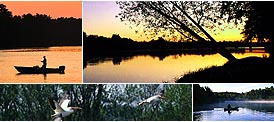
| Redfish | Sailfish | Sharks | Sheepshead | Snapper | Snook | Spanish Mackerel | Spotted Seatrout | Tarpon |

COBIA (LING)
Regulations
Minimum length 33" (fork length); no closed season; 2 per person per day limit
General Information
Cobia are year round residents in south Florida and part time residents in other parts of the state. Along both coasts, anglers notice cobia migrating northward in the spring and to the south in the fall. They travel in small schools and are often seen in the company of large rays. Anglers use the sight of the ray's wing tips breaking the surface of the water as an indication that cobia may be present.
The fish spawn in summer and early fall offshore in the Atlantic Ocean and in the open waters of the northern Gulf of Mexico. Cobia grow quickly. A two year old fish can be 24" in length.
Distribution
Cobia are usually caught offshore but there are some notable exceptions. The fish are full time residents in large west coast bays such as Tampa Bay and Charlotte Harbor. There are also an increasing number of reports of cobia being caught very close to shore and in the passes and backwaters along the southwest coast. Wherever they occur, look for this species around natural and man-made submerged structures. Anglers without boats have the best chance of catching a cobia from land off one of the piers along the Gulf of Mexico coast in the panhandle.
Tackle and techniques
You'll need a medium to heavy duty spinning rod and reel with 15 to 30 pound test line, heavy monofilament leader, and a good drag system on your reel to go after these fighters. This is necessary because the fish, once hooked, makes it's initial runs towards the closest structure. Your job is to turn the fish and keep it from reaching something the fish can use to cut you off. In the summer, when the water is warm, cobia will be close to the surface and you can sight fish for them.
Bait
Cobia have a hard time passing up a small live fish or crab. Free line the bait when the fish are feeding near the surface or use just enough weight to get your bait down but still allow it some freedom to move. A large jig tipped with a chunk of squid is the most successful artificial lure. The goal is to cast ahead of the fish and bring it back towards the fish.












